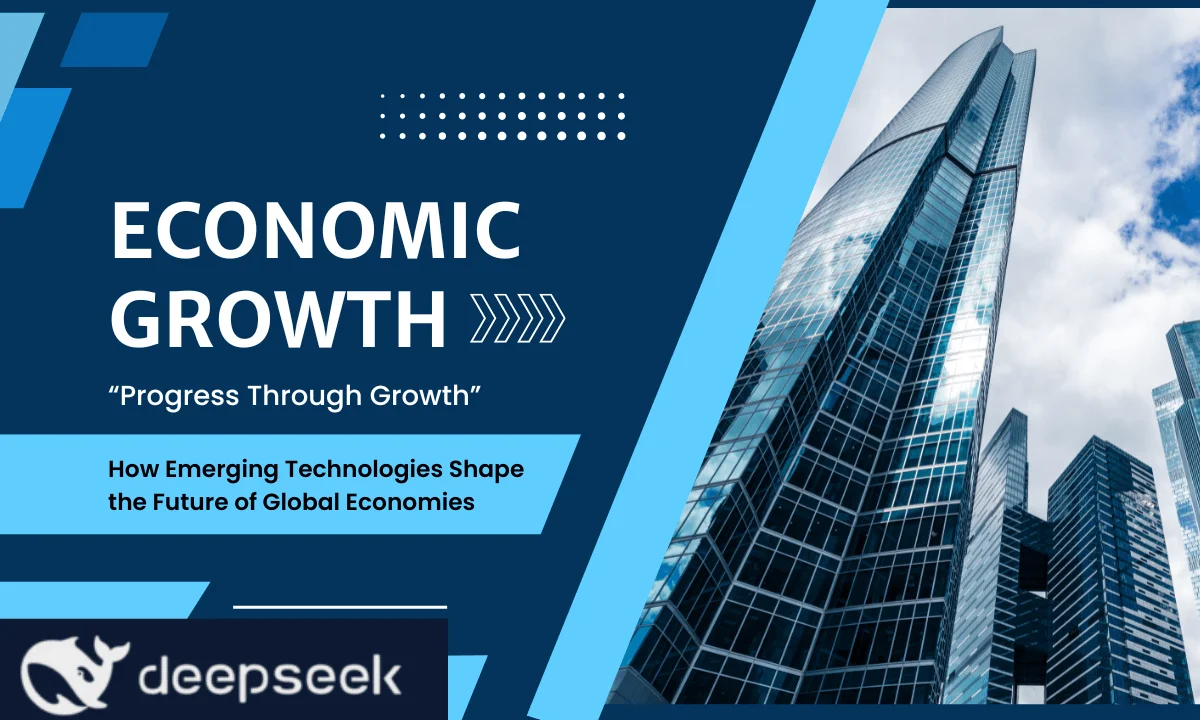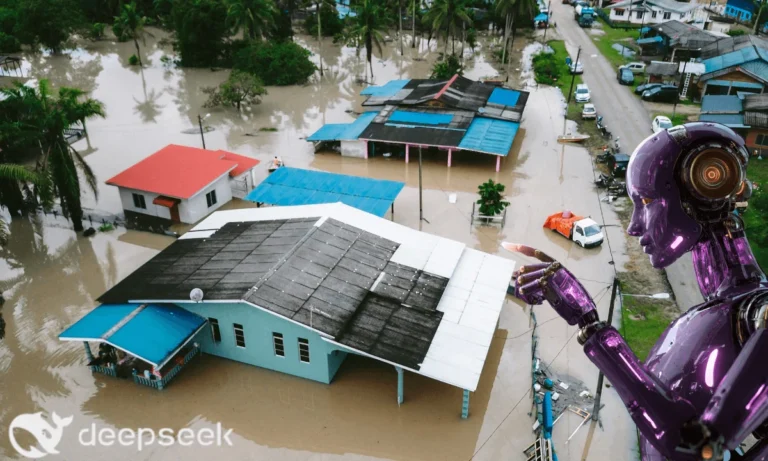Predictive Analytics: Forecasting Pakistan’s Economic Growth with AI
As Pakistan’s economy continues to navigate inflationary pressures, fiscal deficits, and global market uncertainties, modern technologies like Artificial Intelligence (AI) are emerging as powerful tools to guide economic policy and planning. Predictive analytics, a branch of AI, is now being leveraged to anticipate economic trends, enabling smarter decisions, more accurate forecasting, and better resource allocation. In this article, we explore how predictive analytics is reshaping economic forecasting in Pakistan, its current applications, future potential, and the challenges involved in implementation.
Deep Seek Tops the Apple Store – A Game-Changer in AI Technology!
What is Predictive Analytics?
Predictive analytics refers to the use of statistical algorithms, machine learning techniques, and historical data to forecast future outcomes. Unlike traditional economic models that rely heavily on static assumptions and manual data processing, predictive models are dynamic, data-driven, and capable of analyzing massive datasets in real time.
In the context of Pakistan, predictive analytics can be employed to:
- Forecast GDP growth
- Predict inflation trends
- Estimate tax revenues
- Monitor agricultural output
- Anticipate unemployment patterns
- Identify vulnerable economic sectors
These forecasts are critical for policymakers, financial institutions, and international stakeholders such as the IMF and World Bank to make timely and informed decisions.
Deep Seek vs ChatGPT: Which AI Tool Reigns Supreme?
Role of AI in Economic Forecasting
Artificial Intelligence enhances predictive analytics by learning from past data patterns and continuously improving the accuracy of its predictions. Here’s how AI is transforming Pakistan’s economic forecasting landscape:
1. Real-Time Data Analysis
AI systems can analyze real-time data from various sources including satellite imagery, mobile transactions, internet usage patterns, and even weather data. This provides a more holistic view of the economic landscape, especially in agriculture and retail sectors where real-time responsiveness is crucial.
2. Integration with Macroeconomic Models
Traditional econometric models used by institutions like the State Bank of Pakistan are being upgraded with AI-powered tools. These hybrid systems allow analysts to simulate multiple economic scenarios with greater precision and speed.
3. Early Warning Systems
AI can detect anomalies and trigger early warnings for issues like inflation spikes, currency devaluation risks, or declining remittances. This enables proactive policy actions and safeguards national economic interests.
4. Tax Collection & Revenue Forecasting
Predictive tools are helping the Federal Board of Revenue (FBR) improve tax compliance by identifying potential defaulters and projecting tax collections more accurately, leading to better budget planning.
AI and Climate Change: How DeepSeek is Tackling Global Warming
Key Applications of Predictive Analytics in Pakistan
Let’s look at specific sectors where predictive analytics is already playing a significant role in forecasting economic outcomes in Pakistan:
A. Agriculture
Given that a large portion of Pakistan’s economy is agriculture-based, AI models are now being used to predict crop yields, disease outbreaks, and the effects of climate change on agricultural productivity. Startups and government bodies are collaborating to ensure timely advisories and interventions.
B. Energy & Power Sector
AI is helping predict energy consumption patterns across regions, allowing better power grid management and reducing load shedding. Forecasting energy needs also supports sustainable planning for alternative energy investments.
C. Stock Market & Investment Trends
AI-powered platforms can process financial news, global indices, and investor behavior to forecast stock market movements. This helps investors and regulators make data-driven decisions in volatile environments.
D. Labor Market & Employment
Predictive analytics is assisting in identifying unemployment trends based on education levels, geographic distribution, and industry performance. This data supports vocational training programs and job creation strategies.
E. Public Health and Its Economic Impact
Post-COVID, Pakistan has increasingly realized the economic importance of health forecasting. AI is now being integrated to predict outbreaks and their potential impact on the economy, especially in urban centers.
The Rise of Generative AI: Opportunities for Pakistani Creators
Government & Institutional Adoption in Pakistan
Pakistan’s Ministry of Planning, Development & Special Initiatives is gradually integrating AI in national economic strategy. Projects under Digital Pakistan, along with collaborations with universities and data centers, are laying the groundwork for wider AI integration in economic planning.
The Pakistan Bureau of Statistics (PBS) and State Bank of Pakistan (SBP) are also exploring AI models to enhance their forecasting capabilities and reduce dependency on outdated survey-based methods.
Will AI Replace Jobs in Pakistan? Experts Weigh In
Benefits of AI-Powered Economic Forecasting
The integration of predictive analytics and AI into economic forecasting brings several strategic advantages for Pakistan:
- Improved policy accuracy: Smarter insights lead to better fiscal and monetary policies.
- Faster decision-making: Real-time analysis helps reduce delays in economic responses.
- Transparency: AI tools can support public dashboards, making economic data more accessible.
- Risk mitigation: Early identification of crises helps minimize economic shocks.
Quantum Computing + AI: The Next Frontier for Pakistani Innovators
Challenges in Implementation
Despite the promising potential, Pakistan faces several challenges in deploying predictive analytics at scale:
- Data quality and availability: Many sectors lack consistent, digitized, and up-to-date data.
- Skilled workforce: There is a shortage of AI-trained economists and data scientists.
- Infrastructure gaps: Limited access to high-performance computing resources and data centers.
- Policy limitations: Regulatory hurdles and bureaucratic inertia slow down AI adoption.
To overcome these challenges, Pakistan needs a comprehensive AI strategy, increased investment in education, and stronger public-private partnerships.
DeepSeek AI’s Roadmap: Upcoming Features to Watch in 2025
Future Outlook: AI and Pakistan’s Economic Vision 2030
As Pakistan moves toward its Vision 2030 goals, predictive analytics will become essential for strategic planning. With growing urbanization, shifting demographics, and digital adoption, economic data will only become more complex and voluminous. Leveraging AI to process this data will be key to:
- Ensuring inclusive economic growth
- Strengthening institutional capacity
- Increasing resilience against global economic shocks
AI in 2030: What Pakistan’s Tech Landscape Will Look Like
Conclusion
In a rapidly evolving global economy, forecasting Pakistan’s economic growth with AI is no longer a futuristic concept—it’s an emerging necessity. Predictive analytics has the potential to revolutionize how Pakistan navigates economic challenges, plans for development, and builds a more sustainable future. By investing in the right tools, talent, and infrastructure, Pakistan can harness the full power of AI to make smarter, faster, and more impactful economic decisions.
Breaking Barriers: Women in Tech Using DeepSeek AI to Innovate







